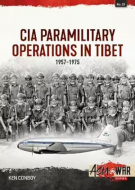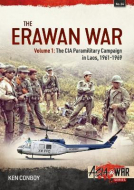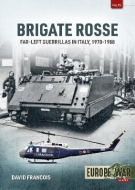
- Agriculture
- Architecture & Design
- Arts & Photography
- Biography
- Business
- Calendars and Diaries
- Childrens (All)
- Childrens (Illustrated)
- Childrens (Picture flats)
- Childrens (Te Reo)
- Classics
- Cooking, Food & Drink
- Craft & Hobbies
- Design (Art / Graphics)
- Design (Interiors)
- Education
- Fashion
- Fiction & Literature
- Fiction - Young Adult
- Gift Ideas
- Health & Wellbeing
- History
- Home & Garden
- Humour & Gift
- Instead of a Card Poems
- Military
- Music
- New Zealand
- NZ (History)
- NZ (Landscapes)
- NZ (Pictorial)
- Poetry
- Reference
- Religion & Faith
- Science & Nature
- Sport & Recreation
- Stationery
- Taschen : 40th Anniversary Edition
- Taschen : BA Basic Art
- Taschen : BU Bibliotheca Universalis
- Te Reo Māori
- Transport
- Travel
Military (455)
|
CIA Paramilitary Operations in Tibet: 1957-1974 (Asia@War 35)
ISBN: 9781804510216 Author: Ken Conboy Publisher: Helion & Company From training camps in the Colorado Rockies to clandestine operations in the Himalayas, this book introduces readers to one of the CIA's most remote covert camp... From training camps in the Colorado Rockies to clandestine operations in the Himalayas, this book introduces readers to one of the CIA's most remote covert campaigns of the Cold War. This is the story of how the US government - primarily through the CIA and often in cooperation with India - came to harness, nurture, and encourage Tibetan defiance in one of the most extreme covert campaigns of the Cold War. In particular, it details an important chapter in the CIA's paramilitary history. In Tibet, new kinds of equipment - aircraft and parachutes, for example - were combat-tested under the most extreme conditions imaginable. New communications techniques were tried and perfected. In many cases, these lessons learned would be applied to other Cold War battlefields like Vietnam, Laos, and elsewhere. Tibet, therefore, became a vital proving ground for CIA case officers and their spycraft. AUTHOR: Kenneth Conboy was South East Asian policy analyst and deputy director of the Asian Studies Centre in Washington D.C., 1986-1992. Since then he has held roles in risk management companies in Indonesia, and he currently serves as Risk Management Advisory Country Manager in Indonesia. He has written a number of books about war in Asia, as well as several articles. 45 b/w photos, 18 colour photos, 3 colour profiles, 3 maps Bind: paperback Pages: 82 Dimensions: 210 x 300 mm Publication Date: 18-11-2022 |
$55.00 |
|
|
Libyan Air Wars Part 2 (Africa@War 21)
ISBN: 9781910294536 Authors: Tom Cooper, Albert Grandolini Publisher: Helion & Company While the first volume in this mini-series spanned the first decade of confrontations between Libya and several of its neighbors, but foremost the USA and Franc... While the first volume in this mini-series spanned the first decade of confrontations between Libya and several of its neighbors, but foremost the USA and France, between 1973 and 1985, the second is to cover the period of less than a year - between mid-1985 and March 1986, when this confrontation reached its first climax. Through mid and late 1985, relations between France and Libya became tense over the situation in Chad. By early 1986, the French felt forced to deploy their air force for an airstrike on the crucial Libyan air base at Wadi Doum, in the north of that country. Tripoli reacted with a high-profile aerial attack on N'Djamena IAP and by bolstering support for its proxies. This eventually provoked Paris to launch its third military intervention in that country, Operation Épervier. Meanwhile, a series of terror attacks on US citizens and interests in Europe and the Mediterranean area took place. While most of these saw the involvement of Iran and Syria too, Libya was recognized as major supporter of the activities in question. In the aftermath of several traumatic experiences, the US administration began planning for direct action against the government in Tripoli and various terrorist organizations supported by it. As the Pentagon planners prepared a contingency list of targets in Libya, and the US Air Force began planning its involvement, ships and aircraft of the US Navy launched intensive operations off the Libyan coast with the aim of provoking an incident that could be used as a reason for major military attack on Libya. Eventually, these operations culminated in Operation Prairie Fire - a series of short but sharp clashes between the US Navy and Libyan air defenses and the Navy, in March 1986. Part 2 of this mini-series provides an unprecedentedly detailed and richly illustrated description of the involved air forces, their equipment and markings, and related military aerial operations, many of which have remained unknown until today, while others have been forgotten outright. Bind: paperback Pages: 72 Dimensions: 210 x 300 mm Publication Date: 11-04-2016 |
$49.99 |
|
|
The Paulista War Volume 1 (Latin America@War 18)
ISBN: 9781912866380 Author: Javier Garcia de Gabiola Publisher: Helion & Company The Year 1932 was not only the year in which the famous carnival of Rio de Janeiro was organized for the first time, or the giant statue of the Christ the Redee... The Year 1932 was not only the year in which the famous carnival of Rio de Janeiro was organized for the first time, or the giant statue of the Christ the Redeemer was placed on top of the Corcovado mountain ridge: tragically, it was also the year of the last civil war fought in Brazil. On 9 July 1932, about 35,000 men from two Brazilian federal states - Sao Paulo and Mato Grosso do Sul - rose in arms against the dictatorship of Getúlio Vargas, demanding the return to constitutionality and democracy. This movement became known as the 'Constitutionalist', while its members became known as the 'Paulistas'. The Brazilian government reacted with brute force: it deployed over 100,000 troops supported by heavy artillery and combat aircraft. The result was the biggest war ever fought in Brazil: the first ever campaign to see strategic aerial bombardment conducted in the Americas; the first aircraft shot down in air combat, and the first to see night bombing operations. Following three months of bitter fighting - which often degenerated into trench warfare - the Paulistas were defeated. Indeed, the end of this conflict brought to the end a period of successive civil wars fought in Brazil since 1889. The Paulista War - the first authoritative account of this conflict ever published in the English language - provides a blow-by-blow account of both aerial and ground combat operations. It is lavishly illustrated with a collection of authentic photographs and exclusive colour profiles, and as such is an indispensable source of reference about this crucial moment in the history of the largest country in South America. Bind: paperback Pages: 80 Dimensions: 210 x 297 mm |
$49.99 |
|
|
Air Power and the Arab World 1909-1955: Volume 4 (Middle East@War 35)
ISBN: 9781914059278 Authors: David Nicolle, Air Vice Marshal Gabr Ali Gabr Publisher: Helion & Company Volume 4 of Air Power and the Arab World continues the story of the men and machines of the first half century of military aviation in the Arab world. The earli... Volume 4 of Air Power and the Arab World continues the story of the men and machines of the first half century of military aviation in the Arab world. The earliest of the Arab air forces to be established trace their histories back to the 1920s and 1930s when the overwhelming majority of Arab countries, and an even larger majority of the Arabic-speaking people, were ruled or dominated by four European powers. This volume continues with the story of the period from 1936-1941. The role, organizational structure and activities of the first Arab air forces are described based on decades of consistent research, newly available sources in Arabic and various European languages, and is richly illustrated with a wide range of authentic photography. These air forces ranged from dreams which never got off the ground, to small forces which existed for a limited time then virtually disappeared, to forces which started very small then grew into something more significant. Even so, the successful air forces of Iraq and Egypt would only have a localized impact within the frontiers of their own states. It was not until the next stage of the story of Air Power and the Arab World that Arab warplanes and Arab airmen would attempt to play a role on the world stage. This fourth volume includes over 100 photos, 5 maps, and 12 color profiles. Bind: paperback Pages: 88 Dimensions: 210 x 297 mm Publication Date: 22-06-2021 |
$55.00 |
|
|
The Sino-Soviet Border War of 1969: Volume 2 (Asia@War 23)
ISBN: 9781914377051 Authors: Harold Orenstein, Dimitry Ryabushkin Publisher: Helion & Company The communist victory in the Chinese civil war resulted in the formation of a new socialist state - the People's Republic of China. The Soviets were the first t... The communist victory in the Chinese civil war resulted in the formation of a new socialist state - the People's Republic of China. The Soviets were the first to recognize the PRC, and subsequently provided China with considerable assistance. After Stalin's death, however, relations rapidly deteriorated over disagreements regarding Stalin's legacy and co-existence with capitalist states. With the 'cultural revolution' in the PRC, these disagreements intensified: the two sides accused each other of revisionism, dogmatism and nationalism. Economic failures and social chaos forced the PRC leadership to seek a method for divesting itself of responsibility for what had taken place. As a solution, they organized a military conflict on the border with the Soviet Union to rally the people around the PRC leadership, while at the same time insignificant enough in scale to prevent it from escalating into a full-fledged war. On 2 March 1969, a specially prepared Chinese army detachment made a surprise attack on Soviet border guards patrolling the border in the area of Damansky Island on the Ussuri River. In the subsequent battle, the dead on both sides numbered more than 50. On 15 March 1969, a much larger battle took place in this same area, in which both sides used artillery and armoured vehicles; the casualties numbered in the hundreds. Bind: paperback Pages: 76 Dimensions: 210 x 297 mm Publication Date: 26-08-2021 |
$49.99 |
|
|
The Erawan War: Volume 1 (Asia@War 24)
ISBN: 9781914377068 Author: Ken Conboy Publisher: Helion & Company During a National Security Council meeting in March 1971, Henry Kissinger commented to those around the table, "When the CIA reaches the point of having the lar... During a National Security Council meeting in March 1971, Henry Kissinger commented to those around the table, "When the CIA reaches the point of having the largest army in Southeast Asia, we better review the program!" He was referring to the secret war brewing in Laos, where the Central Intelligence Agency was training, funding, and leading tens of thousands of indigenous guerrillas within the kingdom and, occasionally, across its borders. The Erawan War mini-series strips away the veil surrounding this conflict, recounting in detail the CIA's largest paramilitary operation of the Cold War, as well as the Royalist armed forces that battled for decades against communist opponents. It includes hundreds of outstanding photos featuring case officers, military hardware, and battle scenes. These volumes are a must for anyone interested in the Vietnam War, military history, special forces units, and CIA paramilitary operations. Bind: paperback Pages: 64 Dimensions: 210 x 297 mm Publication Date: 15-10-2021 |
$49.99 |
|
|
Brigate Rosse (Europe@War 15)
ISBN: 9781914377075 Author: David Francois Publisher: Helion & Company Widespread unrest and political violence shook Italy time and again during the decades following the end of the Second World War, but never as much as during th... Widespread unrest and political violence shook Italy time and again during the decades following the end of the Second World War, but never as much as during the 1970s and the 1980s. Seeking to counter political enemies - including a conglomerate of right-wing movements, organized crime, and top figures in the economic and political life of the country - in order to create a revolutionary state through an armed struggle, and to remove Italy from the North Atlantic Treaty Organization, in 1970, leftists in Italy began to form the Brigade Rosse - the Red Brigades. Organizing themselves following the examples of the Latin American urban guerrilla movements, and also drawing inspiration from the Italian partisan movement of the Second World War, the Brigate Rosse emerged in Trento in 1970. Their early activities were troubled by infighting between 'extremist' and 'moderate' wings of the movement, with the latter accusing some of leaders of having links to the intelligence services of several East European countries. Bind: paperback Pages: 80 Dimensions: 210 x 297 mm Publication Date: 15-12-2021 |
$49.99 |
|
|
Never Ready (Europe@War 16)
ISBN: 9781914377082 Author: Kenton White Publisher: Helion & Company Was Britain's implementation of NATO strategy credible? After the adoption of Flexible Response in 1967 NATO relied on conventional forces to defend the West. B... Was Britain's implementation of NATO strategy credible? After the adoption of Flexible Response in 1967 NATO relied on conventional forces to defend the West. Britain had a central role in NATO's plans, but was British defense planning adequate for the task? How did the Government plan for the use of the conventional Armed Forces for the range of operations it was committed to? How were the Armed Forces to be mobilized, and what was the detail of the planning for mobilization? In 1967 MC14/3 was adopted as the overall strategic concept by NATO. It relied on an escalatory deterrence, from conventional through tactical nuclear strikes to strategic nuclear attack. This is commonly known as Flexible Response and replaced NATO's trip-wire response. The declared principal of the strategic concept was to reduce the chance of mistakenly starting a nuclear war, meeting force with like force, and raising the nuclear threshold in the event of actual war. Bind: paperback Pages: 102 Dimensions: 210 x 297 mm Publication Date: 28-02-2022 |
$55.00 |
|
|
The Battle For The Swiepwald
ISBN: 9781915070494 Authors: Gerard Henry, Frederick Steinhardt Publisher: Helion & Company The battle of Königgrätz was the largest battle ever fought in western Europe until 1914 and its political consequences were no less epic - the demise of Aust... The battle of Königgrätz was the largest battle ever fought in western Europe until 1914 and its political consequences were no less epic - the demise of Austria as a European Great Power, the loss of her historic pre-eminence among the German nations, and the final, incontestable rise of Prussia. Whether Austria could have prevailed at Königgrätz on 3 July 1866 and salvaged her Great Power status is debatable, what is not, is the part the struggle for the Swiepwald played in her ultimate defeat. The insubordination of two Austrian Corps Commanders, and the decision to engage in their epic struggle for control of the Swiepwald forest, would leave 12,000 men dead or wounded within its shattered environs, and the Austrian right flank wide open to the Crown Prince of Prussia's advancing Second Army. This meticulous translation of Heidrich's brilliant monograph takes us through the fighting, hour by hour and foot by bloody foot, in a narrative unsurpassed for detail or accuracy. Bind: paperback Pages: 134 Dimensions: 171 x 248 mm Publication Date: 13-12-2022 |
$69.99 |
|
|
We Were Never There (Europe@War 14)
ISBN: 9781914377129 Author: Kevin Wright Publisher: Helion & Company Devised by Kelly Johnson and initially operated by the CIA, the U-2 is the world's most famous 'spyplane.' It flew at unprecedented altitudes and carried the mo... Devised by Kelly Johnson and initially operated by the CIA, the U-2 is the world's most famous 'spyplane.' It flew at unprecedented altitudes and carried the most sophisticated sensors available, all in the greatest secrecy. Operating from remote locations and without markings, they often took-off before first light. Ostensibly operated by civilians flying meteorological research missions, their bold overflights took them far across Eastern Europe, the USSR, Middle and Far East. However, many details of the aircraft's operational history remain vague and a considerable amount is still classified. Continuing national political sensitivities have meant that much about these early operations has still not been fully revealed even more than 60 years later. This book utilizes a large number of recently declassified documents to explore the remaining hidden details. It provides in-depth examinations of some missions not previously fully described and include more about Norway's role in U-2 operations, and a breakdown of British U-2 overflights of the Middle East using recently released files from the British Ministry of Defence. It examines some of the U-2's extensive efforts to collect intelligence on Soviet ballistic missile test launches and space program, on 'Fast Move' staging operations and lots more from these missions up to May 1960. Chapters explore some of the ground-breaking technology employed by the U-2 to photograph and eavesdrop on Soviet nuclear, military and industrial activities. These include revealing secrets of the Fili heavy bomber production plant, just five miles from the Kremlin. Overflights of the 'Arzamas-16' closed nuclear city, Vozrozhdeniya biological warfare center in the Aral Sea and the mystery that was Mozhaysk. Over 90 photographs, maps and illustrations provide details of the aircraft, the cameras and electronic defensive and eavesdropping systems. The specialized nuclear fallout sampling role is explored and the 'weather packs' installed to substantiate the wafer-thin false cover story of the U-2's role as a 'meteorological research' aircraft. Maps, most never been seen before, record the detailed routes flown by U-2 pilots deep into denied airspace to reveal the secrets of Soviet military, nuclear, scientific and industrial sites. Bind: paperback Pages: 84 Dimensions: 210 x 297 mm Publication Date: 28-12-2021 |
$49.99 |












